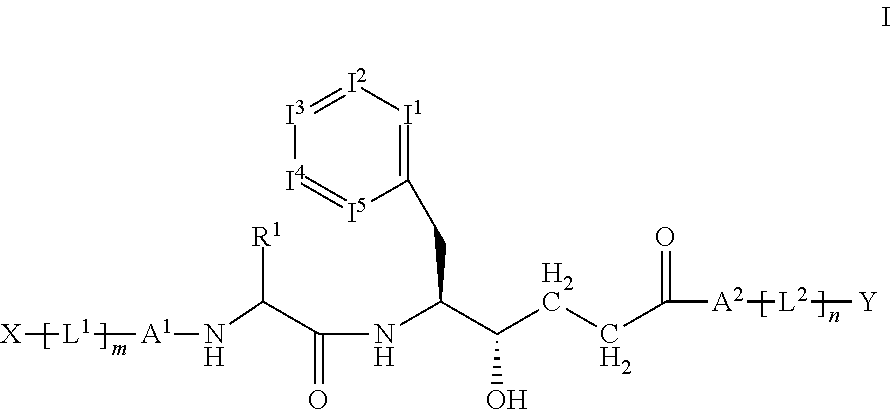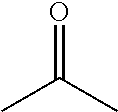Hydroxy-ethylene derivatives for the treatment of arthrosis
a technology of hydroxyethylene and derivatives, applied in the field of hydroxyethylene derivatives for the treatment of arthrosis, can solve the problems of irreversible damage to connective tissue, increased arthrotic changes in supporting joints, and inability to fully explain the occurrence or possible intervention, so as to reduce the ground state energy, reduce the rate of rate-limiting bond breakage, and improve the effect of product distribution ratio
- Summary
- Abstract
- Description
- Claims
- Application Information
AI Technical Summary
Benefits of technology
Problems solved by technology
Method used
Image
Examples
example 2
Preparation of the Compounds of the Formula I According to the Invention
[0224]The compounds according to the invention can be prepared, for example, by the following synthesis sequences by methods known to the person skilled in the art. The examples indicated describe the synthesis, but do not restrict this to the examples.
[0225]Synthesis Sequence:
[0226]Starting from the diprotected building block A-2, which is obtainable from A1 by hydrolysis, the new peptide bond to corresponding amines, amino acid derivatives, dipeptides or tripeptides (typically protected on the C terminal) is built up with the aid of an amide coupling method known to the person skilled in the art, such as, for example, a DAPECI coupling.
[0227]In the second step, the BOC protecting group and the acetal are cleaved off under suitable conditions (for example by HCl / dioxane or TFA / DCM), and the building block obtained is coupled to a corresponding acid, amino acid derivatives, dipeptides or tripeptides (typically i...
example 3
Preparation of (4S,5S)-4-benzyl-5-(2-carboxyethyl)-2,2-dimethyloxazolidine-3-carboxylic acid tert-butyl ester
[0231]
[0232](S)-4-Benzyl-5-(2-cyanoethyl)-2,2-dimethyloxazolidine-3-carboxylic acid tert-butyl ester (30.0 g; 87 mmol; 100.00 mol %) was dissolved in 300 ml of methanol, and potassium hydroxide (300 ml, 40% solution in water) was added. The batch was refluxed until the nitrile had hydrolysed completely. The mixture was subsequently rendered acidic with cooling using citric acid solution (1.5 equiv. based on KOH). The water phase was extracted three times with dichloromethane, the organic phases were combined, washed with NaCl solution until neutral, dried, and the solvent was removed, giving 25.3 g of (4S,5S)-4-benzyl-5-(2-carboxyethyl)-2,2-dimethyloxazolidine-3-carboxylic acid tert-butyl ester as oil (yield 73.5%, content ˜92%). Chromatographic purification on silica gel (eluent: DCM / methanol) starting from 5.0 g of crude product gave 4.6 g of an oil. MS-FAB (M+H+-BOC)=264.1...
example 4
Preparation of (4S,5S)-4-hydroxy-5-{(S)-2-[2-(2-methoxy-5-trifluoromethoxyphenyl)acetylamino]-3-methylbutyrylamino}-6-phenylhexanoic acid N-phenethylamide (A4)
Step 1: (4S,5S)-4-Benzyl-2,2-dimethyl-5-(2-phenethylcarbamoylethyl)-oxazolidine-3-carboxylic acid tert-butyl ester
[0233]
[0234]2.50 g of (4S,5S)-4-benzyl-5-(2-carboxyethyl)-2,2-dimethyloxazolidine-3-carboxylic acid tert-butyl ester, 0.975 ml of phenethylamine, 465 mg of 1-hydroxybenzotriazole hydrate, 1.50 ml of 4-methylmorpholine and 1.45 g of N-(3-dimethylaminopropyl)-N′-ethylcarbodiimide hydrochloride (DAPECI) were dissolved in about 40 ml of DMF in a flask with ice-cooling and stirred overnight. The reaction mixture was poured into saturated sodium hydrogencarbonate solution and stirred for 15 min. The precipitate formed was filtered off with suction, dissolved in DCM and washed a number of times firstly with hydrogencarbonate solution, then with dilute formic acid solution and water. The solvent was removed, and the oily r...
PUM
| Property | Measurement | Unit |
|---|---|---|
| pH | aaaaa | aaaaa |
| pH | aaaaa | aaaaa |
| pH | aaaaa | aaaaa |
Abstract
Description
Claims
Application Information
 Login to View More
Login to View More - R&D
- Intellectual Property
- Life Sciences
- Materials
- Tech Scout
- Unparalleled Data Quality
- Higher Quality Content
- 60% Fewer Hallucinations
Browse by: Latest US Patents, China's latest patents, Technical Efficacy Thesaurus, Application Domain, Technology Topic, Popular Technical Reports.
© 2025 PatSnap. All rights reserved.Legal|Privacy policy|Modern Slavery Act Transparency Statement|Sitemap|About US| Contact US: help@patsnap.com



